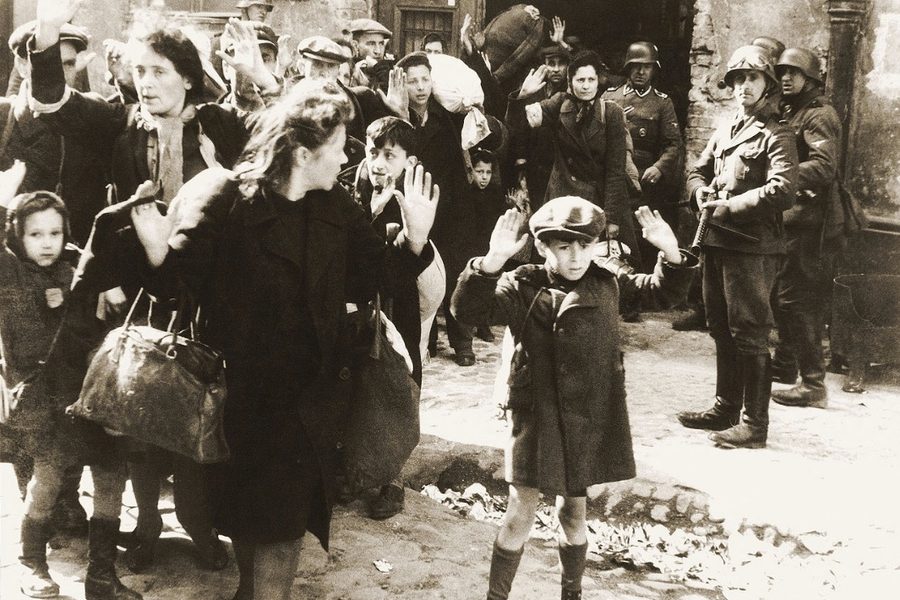
In the summer of 2014, Ta-Nahesi Coates, in an essay for The Atlantic, argued for reparations for the crimes inflicted on the Black population in the making of the United States. Coates crafted a compelling case for compensation for slavery, Jim Crow and ongoing oppression.
Coates did not discuss other crimes which might deserve reparations. He did, however, refer to what he called a successful case of reparations: the money which went from post-war Germany to post-independence Israel. Coates claims these funds, to a country which had just finished expelling most of the native Palestinians, “perhaps provided a road map for how a great civilization might make itself worthy of the name.”
In addition to around $7 billion to the Israeli state, the self-appointed representative of global Jewry, “Individual reparations claims followed — for psychological trauma, for offense to Jewish honor, for halting law careers, for life insurance, for time spent in concentration camps.”
It is too bad that Coates did not check these claims against those in Norman Finkelstein’s The Holocaust Industry, recently reissued by pure coincidence as the debate on reparations ripped through national political discourse.
Before proceeding, perhaps it is necessary to clear up a few things. First, I do not agree with Finkelstein’s advocacy of a two-state solution to the Israel-Palestine conflict. Two, I do not agree with his remarks on the Boycott, Divestment and Sanctions (BDS) movement.
Is that out of the way? Good. Let us discuss the book under review.
First, recall the moment. This book originally appeared in the 1990s, when state and federal governments were pressuring and suing Swiss banks, launching commissions of inquiry, calling for internal audits of 1940s-era banking records, canvassing dormant accounts, and laboriously tracing trails of money long-since gone cold.
Recall also the individual. Finkelstein’s parents were survivors of the Nazi death camps. And then recall some of the recipients of these extracted funds: Jewish “leaders,” “communal institutions” and lawyers jostling to grab a cut of the proceeds. Survivors often died waiting for their share of the reparations.
It is against this tableau that Finkelstein aims to restore “the integrity of the historical record and the sanctity of the Jewish people’s martyrdom.”
After expertly demolishing the notion that these “reparations” actually benefited very many actual survivors of the Nazi atrocities — most went to various community institutions and leaders with no plausible connection to those crimes except for shared religious identification — Finkelstein makes a series of broader arguments. The main one is that post-1967 U.S. political culture has produced The Holocaust, an “ideological representation of the Nazi holocaust.”
The latter was a brutal mass murder, targeting gypsies, Communists, the disabled, Jews and others. The former is real enough but has only a tenuous relationship to historical truth. Instead, “its central dogmas sustain significant political class interests.”
Finkelstein was aware that the Nazi holocaust was scarcely discussed in the postwar United States. As he writes, “American Jewish elites ‘forgot’ the Nazi holocaust because Germany — West Germany by 1949 — became a crucial postwar American ally.” Furthermore, amidst the postwar anti-Communism that suffused U.S. culture, “Remembrance of the Nazi holocaust was tagged as a Communist cause.”
It was only in 1967, after the military defeat of the core Arab nationalist states, that Israel’s military élan “pointed in the right direction — against Israel’s enemies.” Against the suggestion that a militarized Sparta stuck smack in the middle of the Arab world was a danger to U.S. interests, he argues that “[o]nly an Israeli Sparta beholden to American power would do, because only then could U.S. Jewish leaders act as the spokesmen for American imperial ambitions.”
He says this happened through the ideological construction of The Holocaust. It is built on two foundation stones: one, that “The Holocaust marks a categorically unique historical event,” having nothing to do with the crimes of colonialism. And two, “The Holocaust marks the climax of an irrational, eternal Gentile hatred of Jews.”
This unique status long shielded Israel, especially within those states that never “did enough” to defend the Jews during World War II. As he notes, “Holocaust uniqueness — this ‘claim’ upon others, this ‘moral capital’ — serves as Israel’s prize alibi.” Of course, those who make this claim make it selectively. Such crimes suddenly stop being so unique amidst attempts to link Arab leaders to Nazism, from Nasser to Nasrallah.
Finkelstein then raises several questions about this uniqueness. The first is the role of The Holocaust in U.S. intellectual and political culture. Does it crowd out or cover up other crimes? Where, he asks, is the museum dedicated to the crime which was the colonial settlement? Who else suffered at Nazi hands?
In raising such questions, he means to establish that Jews were part of the shared historical experience of victimhood. He refuses to let Jewish victimhood displace the suffering of others. Nazi genocidal brutality did not exclusively target Jews, as the museum implies — “Communists were the first political victims, and not Jews but the handicapped were the first genocidal victims, of Nazism.”
A second move is comparison. Finkelstein first summarizes Germany’s record, having paid out $60 billion. Then, he “[c]ompare[s] first the American record.” After Vietnam, where the United States napalmed and otherwise murdered perhaps 3.8 million people, President Jimmy Carter insisted that “the destruction was mutual.” (About 58,000 U.S. troops died during the war.) He also repeatedly discusses what David Stannard calls the American Holocaust, the destruction of this country’s native peoples. As Finkelstein writes, “Manifest Destiny anticipated nearly all the ideological and programmatic elements of Hitler’s Lebensraum policy. In fact, Hitler modeled his conquest of the East on the American conquest of the West.”
Finkelstein’s coda brings the story back to the United States: “In June 1996 the Native American Rights Fund filed the largest class action lawsuit in U.S. history on behalf of Elouise Pepion Cobell of Montana’s Blackfeet tribe, and 300,000 – 500,000 other Native Americans.” U.S. responsibility for death and material loss during the settler-colonial expansion dwarfs U.S. responsibility for the Nazi crimes. Yet their wholesale slaughter has little place in U.S. historical memory.
Finkelstein highlights how the U.S. colonial settlement ought to be brought within the same frame as Israel. When the book was initially published, such a comparison was not common. And even contemporary discussions of U.S. settler-colonialism seldom raise up First Nations’ political struggles, including for material reparations.
His method is mostly comparative, juxtaposing one crime against another in a forensic deconstruction of U.S. hypocrisy. Perhaps for this reason, one latent point is how the uniqueness dogma walls off the Nazi holocaust from the myriad crimes of the post-1492 European expansion, including its looting of Latin America, Africa and Asia, and their common taproot in European accumulation. After all, concentration camps first emerged as components of colonial counter-insurgency in the Philippines, Cuba, South Africa and Namibia — a lineage which imperial apologists have been eager to erase.
The great Martiniquean poet Aime Césaire saw quickly and presciently the uses and misuses to which Europe and the U.S. were putting the acts of the Nazis. In 1950, Césaire argued in A Discourse on Colonialism that those crimes were “colonialist procedures” visited upon Europe. But it was the location and not the act that was the transgression. The issue was that the Nazis had broken the shop-window of European humanism and laid bare what lay behind it. Césaire suggested that to build a mausoleum only big enough for the memory of Jewish suffering and of Nazi crimes did not represent a real reckoning with European history. To set up a memorial only for Jewish victims could suggest that only Jews had been victims. It represented one more colonial procedure of refusing to solve “the problems it creates,” and of choosing to “close its eyes to its most crucial problems,” branding Europe, as Césaire did, “decadent” and “stricken.”
As he continued, “So-called European civilization … as it has been shaped by two centuries of bourgeois rule, is incapable of solving the two major problems to which its existence has given rise: the problem of the proletariat and the colonial problem.” The colonial problem, of course, was a problem of racism.
Finkelstein is clear that the Nazi holocaust belongs to the same family of crimes as the U.S. crimes against the Vietnamese and Native Americans. In raising reparations of many kinds within the same frame, he brings together Black suffering, indigenous genocide, Nazi crimes and U.S. war-making abroad. He does not explicitly raises questions of reordering society. The book is forensic scholarship, not a manifesto.
Césaire, on the other hand, did write a manifesto. He called for a “policy of nationalities,” or a policy of substantive decolonization. To carry it through, he wrote, was “a matter of the Revolution.” Some may differ on what they call the pragmatism of this proposal. Be that as it may — and has any revolution been the making of pragmatists? — the national debate on reparations, and how great civilizations might make themselves worthy of the name, could use a bit more inclusiveness, especially these days when “political revolution” is on everyone’s tongue.
Such a debate could also touch on how reparations must be material to be substantive — the position of groups like Black Youth Project 100 and Malcolm X Grassroots Movement. It should not be caught in sterile book chat that sets reparations against social democracy, the colonized or enslaved subject against the proletarian. It is about, in the words of the recently dead biologist Richard Levins, keeping “the long view” in mind and “discovering the common ground between different struggles for justice when they seem to conflict because each asks too little.” BYP 100, for example, demands “reparations for chattel slavery,” while also calling for “a guaranteed income for all.” And even if they did not call for the latter, the demand for reparations is plainly just.
So if we are to have a national discussion on reparations — and we should — such a discussion would benefit from keeping in mind that calls for reparations need not be seen as part of an imaginary zero-sum games. It is not as though if Blacks get reparations for slavery, suddenly the supply of justice runs out for the white worker.
But such a conversation should also not strengthen false narratives of German reparations to the Nazis’ victims — especially when the cacophony of those stories overwhelms Palestinians’ anti-colonial claims. Césaire noted that “there is room for all at the rendezvous of victory.” He was right. But in order to achieve that victory, we have to expose the lies about history of those who seek to exclude others from that rendezvous by writing them out of history — claiming for one or another reason that they do not count, a familiar procedure of those who seek to exclude, repress, murder and eliminate. And it is in this task, in fighting against the warping of history that justifies the exclusion of the Palestinians and so many others, that creates worthy and unworthy victims, that The Holocaust Industry truly excels.







